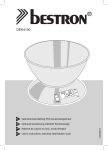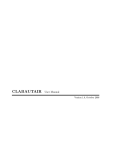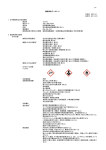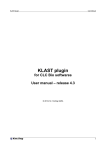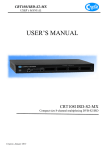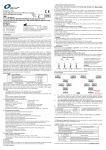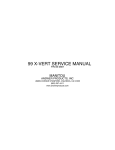Download WAPAM User manual
Transcript
WAPAM User manual Index 1. Wapam, a weighted automata pattern matching...............................................................................3 2Tutoriel : simple example of use........................................................................................................3 With Rdisk..................................................................................................................................3 Without Rdisk.............................................................................................................................6 3Input and output Data.........................................................................................................................7 Input data.........................................................................................................................................7 Form « Multiple Lauch »........................................................................................................7 Ouput data........................................................................................................................................8 Web Format (HTML).............................................................................................................8 XML Format...........................................................................................................................9 CSV Format ...........................................................................................................................9 Notice about the number of results................................................................................................10 4Some details about Wapam functionalities......................................................................................10 Weighted automata (WFA)............................................................................................................10 Wapam and Wapam/Rdisk............................................................................................................12 Performances.................................................................................................................................13 Specific needs................................................................................................................................13 References......................................................................................................................................14 Wapam user manual 20/10/06 Version Page 1/14 Illustrations Index Illustration 1: example of input data filled in the Web interface..........................................................4 Illustration 2: an other example of input data filled in the Web interface : search within a data base. ..............................................................................................................................................................4 Illustration 3: an other example of input data filled in the Web interface : search within a genome...5 Illustration 4: an other example of input data filled in the Web interface : search within a personnal data bank...............................................................................................................................................5 Illustration 5: progression of the compilation of the Rdisk (FPGA) processors before the sequences filtration................................................................................................................................................5 Illustration 6 : the results for the HTML example................................................................................6 Illustration 7: positioning of the job launched in the genocluster tasks queue.....................................6 Illustration 8: example of the output data in HTML format with the option « each sequence matched»...............................................................................................................................................8 Illustration 9: example of results with the option “each match”. In this sequence, the pattern appears twice at the positions 481 and 593.......................................................................................................9 Illustration 10: example of the output data in XML format ................................................................9 Illustration 11 : example of the output data in CVS format .............................................................10 Illustration 12 : a wheighted autamata of D[ILV]x(1,3)A. ..........................................................11 Illustration 13 : example of automata representing a Prosite pattern D[ILV]x(1,3)A..................11 Illustration 14 : example of automata modified ................................................................................12 Illustration 15 : WAPAM Material Achitecture.................................................................................12 Illustration 16 : comparison between the search times of pattern (*: estimates)...............................13 Wapam user manual 20/10/06 Version Page 2/14 1 . Wapam, a weighted automata pattern matching Wapam has been developped by the SYMBIOSE research team and OUESTgenopole® plateform offer an online version on their Web site. Wapam is a fast nucleic and proteic pattern matching tool, with or without errors, against complete genomes, data banks and personnal data banks. The Web interface allows the users to execute the program on a backbone cluster (genocluster) supply by the plateform or to execute the program on a material accelerating Rdisk. Rdisk est a specialized structure realized by the research team SYMBIOSE to reduce the research time of the patttern in the sequences. The first particularity of Wapam is that it treats pattern translated to weighted automata (WFA) (chapter 4). Weighted automata could be generated by Prosite pattern. Each sequence goes along the automata. It return a score / threshold that allow to evaluate the adequacy between the sequence and the pattern. In fact, a score is the substitution errors number. If the score is higher than the threshold fixed, the pattern is detected at the current postition (for example, if one substitution is tolerated, the threshold is equal to 1 and the pattern is detected if the score is equal to or highter than 1. A Wapam research, with or without errors take the same execution time. The other particularity of wapam is the connecting with the prototype Rdisk machine that allow a material accelerating of the computation. During a compilation stage, the pattern automata is translated to a specialized circuit. Each of the 31 processors that Rdisk is composed are parameterized with the circuit. The sequence is divided by 31 pieces that are analysed in each processor. 2 Tutoriel : simple example of use With Rdisk We would search the prosite pattern D[ILV]x(1,3)A in a proteic data base SuissProt. We must generating an automata, clicking on « generate automata ».The automata is visible illustration 1 It's very important to be aware of that if a modification is done and the automata is already generated, you have to regenerate it. In this example, we decide to use Rdisk. Wapam user manual 20/10/06 Version Page 3/14 Illustration 1: example of input data filled in the Web interface It's possible for the user to modify the automata (chapter 4). We could choose de research the pattern in a data bank illustration 2). Illustration 2: an other example of input data filled in the Web interface : search within a data base. We could choose de research the pattern in a genome (so in that case you must to select an organism and one or several chromosoms – to select several chromosoms with the touch «uppercase» and verify that the option « each sequence matched » is selected.) or a personnal data bank (illustration 3 & 4). Wapam user manual 20/10/06 Version Page 4/14 Illustration 3: an other example of input data filled in the Web interface : search within a genome. Illustration 4: an other example of input data filled in the Web interface : search within a personnal data bank. A page of setting on standby post a progression indicator (illustration 5). Illustration 5: progression of the compilation of the Rdisk (FPGA) processors before the sequences filtration. The results are those printed illustration 6. Wapam user manual 20/10/06 Version Page 5/14 Illustration 6 : the results for the HTML example Without Rdisk The data seizures are the same as those in illustration 1, Just don't select the checkbox Rdisk. The Illustration 7, shows the jobs number on standby on genocluster. The request is placed in the waiting jobs before its execution on one of the cluster nodes. Illustration 7: positioning of the job launched in the genocluster tasks queue. The resultats are the same as those shown in the Illustration 6. Wapam user manual 20/10/06 Version Page 6/14 3 Input and output Data Input data The parameters to fill the form are as follows: l l l l l l l Give your email est optional but advised. Certain research can be rather long, you are thus likely to close your navigator and to lose the url on the result page. In any case your result file is saved 5 days on our server. The pattern name is optionnal too. It allows you to distinct yours requests when you execute successive requests. If your pattern is a nucleic pattern you must to specify it. Choose to use Rdisk or not. The specialized machine Rdisk allows you to accelerate your research (see Choisir d'utiliser Rdisk ou non. La machine spécialisée Rdisk permet d'accélérer les calculs (see below). It 's a prototype of research that could be often out of order. Define the target sequences. The platform La plateforme places approximately 200 genomes and 20 data banks at user's disposal. Genomes and data banks could be added, upon request ([email protected]). If you use Rdisk the choice is limited but it could be supplemented too upon request. You can search too within your personnal sequences data bank. Choose the result type : each pattern that match in the sequences (« each match ») or each sequence that match with the pattern « each sequence matched »). Usually, you choose « eatch match » (particulary if the research is made in a genome). Form « Multiple Lauch » Accessible by a bond that is in top on the left form. It allows user to repeatedly launch Wapam on a number of patterns (several patterns in a textfile but not use the Word format). The other input parameters are identical. In this case of use: ● The automata are not modifiable manually. ● The results are sonly send by email. Upon request, one mail by result or a single mail . In that last case, the results are written in a single file. To have more informations on the launching of a whole of patterns or to set up a treatment with Wapam user manual 20/10/06 Version Page 7/14 many patterns, contact [email protected]. Ouput data The 3 formats of results description contain the same data exactly but they are presented differently. Web Format (HTML) The HTML format allows user to visualize the data in a table in your Internet explorer (illustration 8). Illustration 8: example of the output data in HTML format with the option « each sequence matched» The number of results printed on a page can be given by filling the field text “Result per pages” in top of the page (by defect 1500). The recovered data (illustration 6) are: l l l l The chromosome or the sequence name. You can go to the chromosome or the sequence which interests you by clicking at once “jump to” in top of the page. The strand (for the moment research is done only on the strand plus) The position of beginning and the position of end of the sequence printed in the results (and not those of the pattern). The cost or error number Wapam user manual 20/10/06 Version Page 8/14 l l The sequence which you can select the length of posting in maximum field text the “sequences length” in top of the page (by defect 30). The real length of the part of the printed sequence. Illustration 9: example of results with the option “each match”. In this sequence, the pattern appears twice at the positions 481 and 593. XML Format XML Format is a standard format (illustration 10), allowing to save data so that it can be read again easily by an human or a program. You could use it if you wish automatically to treat the data by a script that you would write yourself. Actually, the Web format is produced starting from XML format. Illustration 10: example of the output data in XML format CSV Format Format CVS (illustration 11 ) allows the user to import the data in any software like Excel or Open Office.Calc. It is also translated starting from XML format. CSV Format used by WAPAM is as follows: l the separator of fields is the comma, l the separator of text is the quotation mark. To import a CVS document in Excel : 1. On the WAPAM Web interface, click on the right button of the mouse on the bond 'Description of the results to format CSV '', finally click on 'Recording the target of the bond Wapam user manual 20/10/06 Version Page 9/14 under 2. In Excel : File/Open 3. Select "all" in 'file type' 4. Select the file type CVS adn submit 5. Select all the column A 6. In the menu "Data" select "Convert" 7. Choose option "délimited" and press on "following" 8. Indicate the separator : comma and the indicator of text : the quotation mark 9. Click on finish 10. You just have to format your table as good seems to you. Illustration 11 : example of the output data in CVS format Notice about the number of results We limited the Wapam results number (by genocluster: 2000/by Rdisk: 500). Indeed, a request with a too great number of results appears not easily interpretable: it is then preferable that the user biologist refine his research. It is however possible to increase these thresholds by contacting [email protected]. 4 Some details about Wapam functionalities Weighted automata (WFA) An automata characterizing a pattern will be represented by the whole of the positions of the pattern, connected between them by transitions (illustration 12). The automata is weighted, i.e. that each transition is labelled by a letter which can be read according to the alphabet of the sequence (nucleic or proteic bases) and by a weight. The sequence gradually “goes along” the automata, and, with each position, the weight of its transition is added to the score. This weight reflects the adequacy of the target sequence part (banks or genome) with the letter read with this position in the pattern. By defect this weight is equal to 1 if the letter is not the same one (substitution) and to 0 if it is the same one. Wapam user manual 20/10/06 Version Page 10/14 The reason is recognized when the final state is active with a score higher or equal to the score or fixed threshold of error. For example if an error is tolerated the threshold will be equal to 1. On l'illustration 12 presenting an example of weighted automata, each round is a state, each arrow is a transition. Illustration 12 : a wheighted autamata of D[ILV]x(1,3)A. The automatas used by Wapam are in the following form (illustration 13). For example, if the portion of sequence which goes along the automatq go from state 0 to 1 by reading D the cost is 0 if not the cost is 1. Illustration 13 : example of automata representing a Prosite pattern D[ILV]x(1,3)A. The weights can be more general than the simple calculation “0/1”; it is possible to modify the automata manually. For example the substitution of D by NR, R or A in first position can cost 3 instead of 1 (Illustration 14). Wapam user manual 20/10/06 Version Page 11/14 Illustration 14 : example of automata modified . The platform has other tools to generate waighted automatas (generation of weights “to the BLOSSUM”, use of matrices weights/position PWM…) Contact [email protected] for questions on this subject. Wapam and Wapam/Rdisk Wapam can be used in two ways (Illustration 15) either it is launched on genocluster (like all the other softwares of the platform) and research is done on a node of the cluster, or it is coupled with Rdisk which parallels research on a whole of charts. Illustration 15 : WAPAM Material Achitecture. Rdisk is a specialized architecture made up of several tens of charts (currently 31). Each chart contains a reconfigurable processor (FPGA) coupled to a hard disk. The weighted automatas are directly wire up the FPGA, which allows a simultaneous evaluation of the states. This wiring uses as many material elements as states transitions in the automata. The processors Wapam user manual 20/10/06 Version Page 12/14 have a surface being able to wire up automatas having until a hundred transitions. The 31 charts share the courses of the bank or the genome (1/31th by chart). The whole of the Rdisk prototype was conceived to filter the data bases quickly, the hard disks are directly connected to processors FPGA. Rdisk is a prototype of research, so it is not always in operating state. If you need intensive calculations in search for patterns, contact the platform ([email protected]) so that we set up an adapted treatment of your data or your patterns. Performances The illustration16 presents a comparison of the pattern search times between the Wapam software implementation and the Wapam/Rdisk material acceleration (average on 50 patterns taken by chance among a whole of 3331 patterns). Not to overload the server, the research can be stopped as soon as there is more than one certain number of results (hitchhiking). In all the cases, a research with Wapam with or without errors takes the same execution time. On the software version, the execution time is linear compared to the size of the automata (and thus of the pattern). With Wapam/Rdisk, all the patterns are treated in same time (as long as they are accepted by Rdisk, i.e. as long as there is not more than one hundred of transitions). Wapam software Wapam + autostop 2000 Wapam/Rdisk Wapam/Rdisk + precompilation 1 pattern 2605 s 2003 s 72 s 23 s 3331 patterns 100 days* 77 days* < 3days < 1day Illustration 16 : comparison between the search times of pattern (*: estimates) The acceleration brought by Rdisk is even more important starting from the second launching, when the patterns were already compiled, because Wapam/Rdisk remembers the weighted automatas compiled previously. The modification of the error threshold doen't require a new compilation. Specific needs We are at your disposal ([email protected]) to collaborate on particular tasks, such as for example: ● to add other data banks, ● to produce weighted automatas meeting particular aims, Wapam user manual 20/10/06 Version Page 13/14 ● ● to set up on the cluster or Rdisk intensive calculations (great number of sequences, of patterns/ automatas, reiterated launchings, analyzes results…); we can finely parameterize Wapam to obtain the best computing times on your application, To allow you to access to Wapam by commands lines on genocluster References Thank you to quote the following reference in your work using Wapam. Stéphane Guyetant, Mathieu Giraud, Ludovic L'Hours, Steven Derrien, Stéphane Rubini, Dominique Lavenier, and Frédéric Raimbault. Cluster of reconfigurable nodes for scanning large genomic banks. Parallel Computing, 31(1):7396, 2005. Wapam user manual 20/10/06 Version Page 14/14















